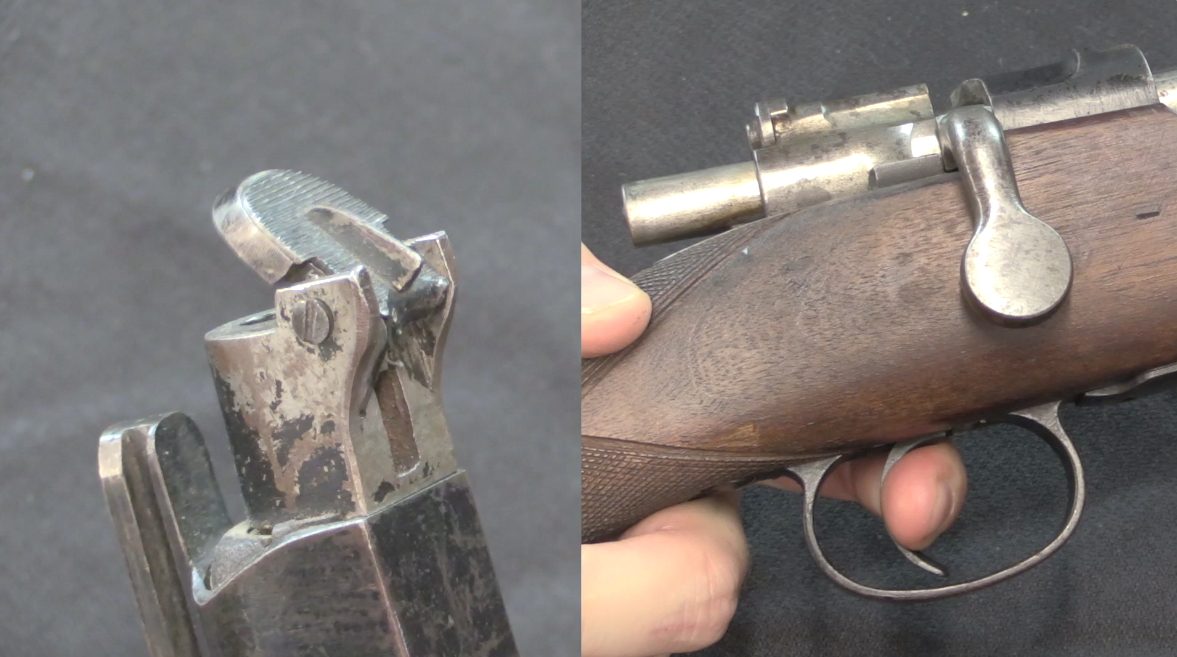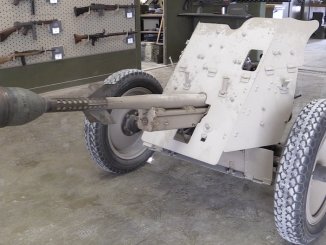Forgotten Weapons merino wool hoodies from Varusteleka:
https://www.varusteleka.com/en/product/forgotten-weapons-sarma-merino-wool-hoodie/72488
The DWM company in Germany had a license on the Maxim gun design prior to World War One. They produced the rather old-fashioned MG08 for the German army, but also wanted to have a modernized type of gun for commercial sales. This was the Model 1913 Parabellum, with the design improved by Karl Heinemann. Like the Vickers, Heinemann’s improvement included inverting the lock to reduce the size of the receiver box. He also moved the mainspring inside the receiver and simplified the lock.
The gun was formally adopted by the German military as the Model 1914 for aircraft use. The water jacket of the original design was slotted like the lMG08 and it was used as a flexible observer’s gun. It had a rate of fire around 1000 rpm – much faster than the MG08 and 08/15, which definitely suited aerial use. An improved version was adopted as the 1914/17, with the barrel jacket reduced in diameter and a 3x telescopic sight fitted. This final version weighted just 22 pounds (10 kg).
After the war, production of the Parabellum simply ended. None of the guns were officially taken by the US as war reparations (unlike the MG08 and 08/15, which were Brough back to the US in large numbers) and all the different patterns (water-cooled 1913, air cooled 1914, and lightened 1914/17) are extremely scarce today. Many thanks to Limex for giving me access to film this one for you!




Is that the first and most silly use of a scope in an aircraft machinegun role? Scoped machine guns are not really a practical sighting system for an area of effect weapon, and at altitude and speed would seem to render the gun less functional in that specific application due to field of view limitations.
Perhaps the scope was for target identification? I’ve seen USAF F-15s with a rifle scope mounted next to the HUD, because the IFF wasn’t foolproof.
Good Lord! Low tech meets high.
I wonder how much “Patent Avoidance Syndrome” was going on with that lockwork…
This is one of those places I really wish we still had the habit of linking documentation like supporting patents with the weapon videos around here. It would be fascinating to do a compare/contrast with the Vickers guns in order to examine just what was going on… I would almost be willing to lay rather large amounts of cash on the premise that this thing was specifically designed so as to get around the Vicker’s patents.
Which would have enabled DWM to break out of the market-lock they were in with the Maxims, and would have been in if they’d simply licensed production of the Vickers. I’m just surprised that they didn’t turn these into the MG08/15.
Any idea about rate of fire, Ian?
Description claims
“(…)had a rate of fire around 1000 rpm(…)”
when contrasted with
“(…)Any idea about rate of fire(…)”
I must ask: is this some hermetic joke?
I actually didn’t read that thoroughly… Listening to Ian, I don’t remember him saying anything in video. Could be wrong…
In what way? The main difference seems to be that the Parabellum used a compression spring, while the Vickers stuck with the fusee spring from the Maxim (which the Germans had rights to manufacture).
I agree with your final point, though. Less metal, more ergonomic (and probably reliable) without an external crank handle flopping around – why keep building 08s?
“(…)patents(…)”
According to US1128310A
https://patents.google.com/patent/US1128310A
by AUGUST ALBERT KARL HEINEMANN
The objects of the improvement are first, to provide a stock the end face of which is located in the direction of the axis of the bore of the barrel, so that the recoil pressure will act in a central direction upon the shoulder of the gunner, whereby the steadiness of the gun will be increased during firing; second, to provide a breech block mechanism which is exceedingly simple in construction, of a small weight and efiicient in use; third, to provide a cartridge feeding mechanism wherein the length of the stroke of the belt-slide is terminated and made independent of the varying lengths of the recoils of the barrel, so that the feeding stroke of the belt-slide will be in all cases the same; fourth, to provide a cover for the receiver which affords facilities in etting access to the interior thereof; and fifth, to provide a muzzle attachment which is adapted, during firing, to be acted upon in downward direction by the propelling gases leaving the muzzle’ in order to steady the latter thereby preventing or counteracting the bucking of the muzzle, that is to say, its tendency to jump upward after a shot and diminishing…
Such a high magnification in an aircraft sight does really seem counterproductive. Telescopic sights of the Aldis type were commonly used in WW1 and inter-war aircraft, but they usually had 1× or at most 1.5× magnification. Some aircraft such as some Japanese fighters even had that type of sight in WW2, as did the Soviet Polikarpov series fighters (I-15 etc.). I am not sure what their magnification factor was, but I doubt it was as high as 3×.
“(…)Soviet Polikarpov series fighters (I-15 etc.)(…)”
Some I-15 and I-16 were equipped with ОП-1
According to manual https://libcats.org/book/539425
it has 1x magnification and field of width 21…23 degrees
According to http://www.airforce.ru/history/romanov/chapter3/page3.htm it was derived from English Aldis sight. Since 1937 I-16 and I-153 fighter were furnished with another sight namely ПАК-1 (reflex sight, derived from German REVI sight)
Gotta consider… “Aircraft” in those days included barrage balloons and observation balloons. A telescopic sight on one of those would make a lot of sense.
Also, the Parabellum was the standard flexible (ring mount) gun on the Gotha G IV bomber.
When you’re in a fairly slow (max. AS 70 KTS) bomber, being able to effectively target and engage a fighter coming up at you beyond the 200 yards or so considered effective fighter gun range in those days made pretty good sense.
cheers
eon
Ref MG08 and MG08/15 war booty. The US Army apparently had vague ideas of converting them to 30-06 and storing them for issue in a mobilization, but eventually gave up on the idea (due to funding issues, no doubt). After rotting in a warehouse for years, they were sent to Davy Jones locker off the New Jersey coast (I’d love to know exactly where) in 1940.
Off the New Jersey coast. I’m sure they went out far enough to ensure when dumped they made it to the bottom of the Hudson Canyon.
Colonel:
How helpful of the US authorities. The Home Guard could have made good use of those guns. Britain made 7.92mm for the Besa, so ammunition would have been available. They would have been a welcome addition to a force armed with shotguns and spears in 1940.
Perhaps the scope is for shot placement,much akin to scoped revolvers for bear hunting.
We have fun calling elaborate design and machining “typically German” or “typically Swiss,” but there’s something reassuring to the user in seeing and handling precise and well thought out mechanisms. A man who knows he’s heading for the trenches doesn’t care how much his weapon costs to make, and if the screw slots line up and the heads are numbered, he’ll know that some elderly bearded men wearing silk skullcaps and full-length leather aprons, men who can make absolutely anything out of steel, are backing him up. At least that’s how it felt to this gunsmith’s little boy when he was training with M14s in the days of Lydon Johnson.
The man heading to the trenches may not care about the price, but you can bet he’d rather have someone else with him carrying the same half-price weapon than just him with the full-price weapon.
Very valid point , ‘Quantity has a quality all it’s own’ atrib. to Stalin
There’s a Venn Diagram out there to be drawn, wherein the optimal state is somewhere between the ideals of craftsmanship and affordability. Attaining that state of perfect balance, however? Rarely, if ever, achieved.
Thing is, there’s something of a ratchet effect that goes on. If you pause to think about it, the never-ending battle between defense and attack only really results in better and better attacks meeting better and better defenses. The essential futility of it all doesn’t ever seem to bother anyone, though.
Art or economy, which is better? Well, ideally, you want both, all at once.
Performance vs. affordability is a valid argument, but “craftsmanship” introduces a bit of a false dichotomy.
Modern-collector nostalgia aside, manufacturers didn’t use 17 parts to do the job of one, or spend a day turning a blowback tubegun receiver from 32 pounds of barstock, because it conferred tactical advantages, and certainly not better reliability. Nor did they stop because the folks buying $13B ships and $2B bombers couldn’t afford “quality”. Inventors made their best guesses while treading new ground, did what they could as long as they had to, then dropped oldthink as soon as they found better ways.
And *externally* it reminds me of the later m1919 by some fellow named Browning. Had someone thought of making a ground mount for this, it could have been somewhat nightmarish to both face and support logistically.
“(…)someone thought of making a ground mount for this(…)”
According to https://guns.fandom.com/wiki/Parabellum_MG_14
MG 14/17 was Sometimes fitted with bipods for ground use.
Hah, here Limex (a pun on a word sheetmetal steel) was a local company known for en masse importing cheap bicycles in the 90s!